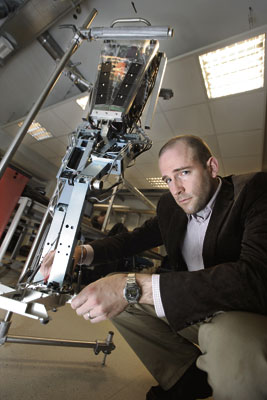A spring-powered artificial foot will halve the extra energy amputees need for walking with prostheses. The device was developed by dr Steven Collins, currently a TU postdoc in the BioRobotics Laboratory.
You may be surprised by how human walking will be improved within the next ten years, predicts dr Steven Collins, who has recently been offered a post as a professor of biomechatronics at Carnegie Mellon University (US). Not only will athletes like Oscar Pistorius outrun their able-bodied colleagues on super springy artificial legs, but special spring-powered shoes will make walking easier for all of us.
“The basic mechanics of walking are the same for both humans and robots, like Denise or Flame”, says Collins, a postdoc at the faculty of Mechanical, Maritime and Materials Engineering’s BioRobotics Laboratory. “In the simplest model you describe walking as a mass moving on top of a leg, like an inverted pendulum, with the foot acting as a pivot. The swing phase in which the weight moves forward over the foot doesn’t cost any energy, but switching from one leg to the other does require work, because energy is lost in the collision when the foot of the other leg hits the ground.” So although in theory moving along at a slow and constant speed requires no energy, it is the energy that got lost in transitioning between steps that causes an energy drain that needs to be replenished. And like humans, the walking robots developed by TU Delft do that with powered ankles. “The ankle pretty much does all the push-off, since that’s the most effective way”, Collins explains.
Last month he published an article (in PLos ONE, 17 February 2010) on how humans walking using a prosthesis can be improved by much the same technique that propels the robots: storing energy in the ankle when the foot first hits the floor and then re-using it at push-off.
Collins and his co-author, Arthur Kuo, of the University of Michigan, have developed a unique artificial foot that uses a spring to buffer the energy in walking. In their article they clearly explain how it works: “When the heel contacts the ground at the beginning of a stride, the rear-foot component rotates and compresses a coil spring. At maximum compression, the rear-foot is latched by a continuous one-way clutch. Rather than releasing the spring energy spontaneously, our prosthesis stores it until sufficient load is detected on the forefoot. It then releases the forefoot, and the spring provides push-off as the person begins to unload the trailing leg, with timing similar to normal ankle push-off. A small return spring resets the device during the ensuing swing phase, so that the rear-foot is in position for the next step.”
The two researchers tested the device on eleven healthy young men wearing specialized boots to disable their ankles. An artificial foot (either conventional or spring-powered) was attached under one boot, while a lift shoe was worn on the other foot to compensate for height. This enabled comparisons to be made between normal walking, conventional (passive) prosthesis use and the energy-recovering prosthesis. Energy expenditure was measured by analysing the O2 and CO2 levels in the test subject’s breath. It turned out that walking with a conventional prosthesis requires 23 percent more energy than normal walking, which is comparable to carrying a 20 kilogram load. The new prosthesis developed by Collins and Kuo reduced that figure to 14 percent more energy. The ankle push-off was restored from about 10 Watts, in the case of normal prosthesis use, to 20 Watts, which is about the normal value.
Tests are currently under way with amputees, and thus far the anecdotal evidence is good. People say they can actually feel the force from their phantom limb. Collins says that manufacturers of artificial feet (largely unchanged for the past fifty years) have reacted with interest. They are keen to implement his energy-recovering technology. “Problems applying this technology are not so much technical as procedural”, Collins concludes.
Nevertheless he expects commercial availability within five years.
,
Perhaps you, like many, were recently shocked to learn that Myriad, a biomedical company, holds a patent on two forms of the gene that is associated with breast cancer. This patent not only protects Myriad’s genetic screening test, which helps predict whether one will get breast cancer, but it also prevents other companies from developing similar tests. Unfortunately, patents may also prevent basic research. Myriad used their patent to try to shut down breast cancer research being done at Yale University. In The U.S., they can do this as that research necessarily involved making copies of the genes that they now monopolize with their patents, and unlike Europe, there is no research exception.
The American Civil Liberties Union (a U.S. civil rights NGO) recently sued Myriad on behalf of those researchers and cancer victims. While the European Patent Office does not allow claims on gene sequences, they recently reversed their 2004 decision denying Myriad’s patent in Europe, and the test to be patented. Does this indicate a trend by which Europe may eventually allow gene patents?
Patents have been granted for unmodified human genes for the last decade. This is because Craig Venter’s company, Celera, began patenting genes in the 1990s. Other companies quickly followed. The Human Genome Project was publicly-funded and produced basic scientific knowledge in the public domain, but Celera began patenting genes. The U.S. Patent and Trademark Office accepted Celera’s strained legal interpretation of cases that made owning engineered life forms possible. Now, more than 20% of human genes are patented, including genes for several diseases like breast cancer.
Einstein worked in a patent office, yet he never applied for a patent on the theory of relativity. It wasn’t his invention after all. Nor are the unmodified genes for which countless patents have already been granted the inventions of the patent holders, although we should be grateful for these discoveries, and industry will doubtless make useful, patentable inventions based upon these discoveries.
New chemical products, which might be composed of well-known chemicals that cannot receive patents, may be patentable as new compositions of matter not otherwise found in nature. Similarly, new combinations of genes could be patentable. But genes identified as causing diseases, or associated with propensities toward diseases, should not be owned by anyone.
Laws of nature should not be patented, this was settled by the U.S. Supreme Court in Gottschalk v. Benson in 1972, when the court held that a patent was not available for a mathematical formula because “the patent would wholly pre-empt the mathematical formula and in practical effect would be a patent on the algorithm itself.” Simply put, mathematics depicts laws of nature. Genes are akin to gravity or mathematical truths: they are the products of nature itself. There is no sense in which the laws of mathematics or the strings of base pairs in unmodified human genes are new, only their applications through specific technologies may be inventive.
The ACLU’s case is based on sound legal precedent, just as the decade-long practice of patenting unmodified gene sequence is not. The PTO has made mistakes before, but none that has so directly impaired science that might otherwise benefit the public. This lawsuit, much of which centers around the public status of scientific knowledge, and the intended role of patents, is a long overdue and welcome defense of the free pursuit of knowledge and science. Let’s hope that a win for the ACLU will help prevent a similar trend in Europe. Myriad’s patents affect scientists and those suffering from breast cancer, making research difficult, and detection unduly expensive.
David Koepsell is the author of Who Owns You?: The Corporate Gold Rush to Patent Your Genes (Wiley-Blackwell 2009). He has a law degree and a PhD in philosophy from the University of Buffalo, and teaches Ethics and Technology at the Delft University of Technology in the Netherlands. He has a blog tracking this case at http://whoownsyou-drkoepsell.blogspot.com/

You may be surprised by how human walking will be improved within the next ten years, predicts dr Steven Collins, who has recently been offered a post as a professor of biomechatronics at Carnegie Mellon University (US). Not only will athletes like Oscar Pistorius outrun their able-bodied colleagues on super springy artificial legs, but special spring-powered shoes will make walking easier for all of us.
“The basic mechanics of walking are the same for both humans and robots, like Denise or Flame”, says Collins, a postdoc at the faculty of Mechanical, Maritime and Materials Engineering’s BioRobotics Laboratory. “In the simplest model you describe walking as a mass moving on top of a leg, like an inverted pendulum, with the foot acting as a pivot. The swing phase in which the weight moves forward over the foot doesn’t cost any energy, but switching from one leg to the other does require work, because energy is lost in the collision when the foot of the other leg hits the ground.” So although in theory moving along at a slow and constant speed requires no energy, it is the energy that got lost in transitioning between steps that causes an energy drain that needs to be replenished. And like humans, the walking robots developed by TU Delft do that with powered ankles. “The ankle pretty much does all the push-off, since that’s the most effective way”, Collins explains.
Last month he published an article (in PLos ONE, 17 February 2010) on how humans walking using a prosthesis can be improved by much the same technique that propels the robots: storing energy in the ankle when the foot first hits the floor and then re-using it at push-off.
Collins and his co-author, Arthur Kuo, of the University of Michigan, have developed a unique artificial foot that uses a spring to buffer the energy in walking. In their article they clearly explain how it works: “When the heel contacts the ground at the beginning of a stride, the rear-foot component rotates and compresses a coil spring. At maximum compression, the rear-foot is latched by a continuous one-way clutch. Rather than releasing the spring energy spontaneously, our prosthesis stores it until sufficient load is detected on the forefoot. It then releases the forefoot, and the spring provides push-off as the person begins to unload the trailing leg, with timing similar to normal ankle push-off. A small return spring resets the device during the ensuing swing phase, so that the rear-foot is in position for the next step.”
The two researchers tested the device on eleven healthy young men wearing specialized boots to disable their ankles. An artificial foot (either conventional or spring-powered) was attached under one boot, while a lift shoe was worn on the other foot to compensate for height. This enabled comparisons to be made between normal walking, conventional (passive) prosthesis use and the energy-recovering prosthesis. Energy expenditure was measured by analysing the O2 and CO2 levels in the test subject’s breath. It turned out that walking with a conventional prosthesis requires 23 percent more energy than normal walking, which is comparable to carrying a 20 kilogram load. The new prosthesis developed by Collins and Kuo reduced that figure to 14 percent more energy. The ankle push-off was restored from about 10 Watts, in the case of normal prosthesis use, to 20 Watts, which is about the normal value.
Tests are currently under way with amputees, and thus far the anecdotal evidence is good. People say they can actually feel the force from their phantom limb. Collins says that manufacturers of artificial feet (largely unchanged for the past fifty years) have reacted with interest. They are keen to implement his energy-recovering technology. “Problems applying this technology are not so much technical as procedural”, Collins concludes.
Nevertheless he expects commercial availability within five years.


Comments are closed.